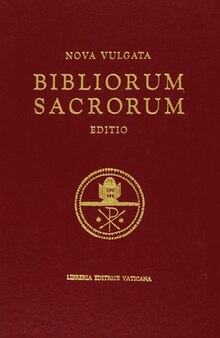
Back Неавульгата Byelorussian Nova Vulgata German Nova Vulgato Esperanto Nova Vulgata Spanish Néo-Vulgate French Nova Vulgata Croatian Nova Vulgata Italian Nova Vulgata Latin Nova Vulgata NB Neowulgata Polish
| Nova Vulgata | |
|---|---|
 Nova Vulgata 1986 cover | |
| Other names | Neo-Vulgate, New Latin Vulgate, New Vulgate |
| Language | Latin |
| Complete Bible published | 1979 (2nd revised edition in 1986) |
| Textual basis | Vulgate |
| Religious affiliation | Catholic Church |
| Website | Nova Vulgata- Bibliorum Sacrorum Editio (vatican.va) |
In principio creavit Deus caelum et terram. Terra autem erat inanis et vacua, et tenebrae super faciem abyssi, et spiritus Dei ferebatur super aquas. Dixitque Deus: “Fiat lux”. Et facta est lux. [1]
Sic enim dilexit Deus mundum, ut Filium suum unigenitum daret, ut omnis, qui credit in eum, non pereat, sed habeat vitam aeternam. | |
| Part of a series on the |
| Bible |
|---|
 |
|
Outline of Bible-related topics |
The Nova Vulgata (complete title: Nova Vulgata Bibliorum Sacrorum Editio, transl. The New Vulgate Edition of the Holy Bible; abr. NV), also called the Neo-Vulgate, is the Catholic Church's official Latin translation of the original-language texts of the Catholic canon of the Bible published by the Holy See. It was completed in 1979, and was promulgated the same year by John Paul II in Scripturarum thesaurus. A second, revised edition was published in 1986. It is the official Latin text of the Bible of the Catholic Church. The Nova Vulgata is also called the New Latin Vulgate[2] or the New Vulgate.[3]
Before the Nova Vulgata, the Clementine Vulgate was the standard Bible of the Catholic Church.[4]
The Nova Vulgata is not a critical edition of the historical Vulgate. Rather, it is a text intended to accord with modern critical editions of the Hebrew and Greek Bible texts, and to produce a style somewhat nearer to Classical Latin.[5]
- ^ "NOVA VULGATA- Bibliorum Sacrorum Editio". www.vatican.va. Archived from the original on 24 May 2023. Retrieved 4 March 2024.
- ^ "Catholics get 'The Message' in new edition of Bible". National Catholic Reporter. 26 July 2014. Archived from the original on 17 January 2020. Retrieved 17 January 2020.
Griffin said he used the Catholic-approved New Latin Vulgate as the basis for his translations. The Latin was no problem for him, he said, but finding English expressions that were both faithful to the Latin meaning and suitable for a contemporary audience was a challenge.
- ^ "To members of the Pontifical Commission for the New Vulgate (April 27, 1979) | John Paul II". www.vatican.va. Archived from the original on 14 October 2020. Retrieved 13 October 2020.
- ^ Houghton, H. A. G. (2016). The Latin New Testament: A Guide to Its Early History, Texts, and Manuscripts. Oxford University Press. p. 132. ISBN 9780198744733.
The standard Bible of the Roman Catholic Church until 1979 was the Clementine Vulgate, prepared for Pope Clement VIII in 1592.
- ^ Stramare, Tarcisio (1981). "Die Neo-Vulgata. Zur Gestaltung des Textes". Biblische Zeitschrift. 25 (1): 67–81. doi:10.30965/25890468-02501005. S2CID 244689083.